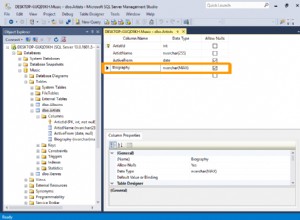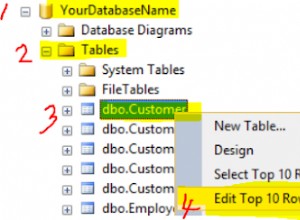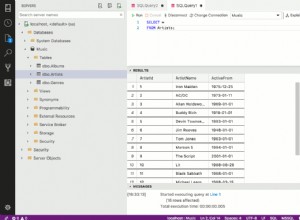Innanzitutto, quelle variabili di ambiente sembrano sospette. Dai un'occhiata alla documentazione per l'immagine Docker ufficiale
, e nota che hai bisogno di POSTGRES_DB , POSTGRES_USER e POSTGRES_PASSWORD , anziché DB_NAME , DB_USER e DB_PASS .
A parte questo, sembra che tu sia per lo più sulla strada giusta. Ecco un esempio completo:
Innanzitutto, avvio un container Postgres. Sto individuando la memoria persistente da qualche parte al di fuori della mia home directory, perché, come hai già notato, i file non saranno di tua proprietà, il che può creare confusione nella tua home directory (sebbene non necessariamente problematico):
docker run --rm --name postgres \
-v /tmp/postgres:/var/lib/postgresql/data \
-e POSTGRES_DB=larstest \
-e POSTGRES_USER=lars \
-e POSTGRES_PASSWORD=secret postgres
Poiché questa è la prima volta che avvio postgres puntando a quella directory di dati, lo vedremo inizializzare il database:
The database cluster will be initialized with locale "en_US.utf8".
The default database encoding has accordingly been set to "UTF8".
The default text search configuration will be set to "english".
Data page checksums are disabled.
fixing permissions on existing directory /var/lib/postgresql/data ... ok
creating subdirectories ... ok
selecting default max_connections ... 100
selecting default shared_buffers ... 128MB
selecting dynamic shared memory implementation ... posix
creating configuration files ... ok
running bootstrap script ... ok
performing post-bootstrap initialization ... ok
syncing data to disk ... ok
Success. You can now start the database server using:
Ora, da un'altra finestra, posso collegarmi ad esso...
$ psql -h 172.17.0.4 -U lars larstest
Password for user lars:
psql (9.5.4, server 9.6.0)
WARNING: psql major version 9.5, server major version 9.6.
Some psql features might not work.
Type "help" for help.
...e crea dei dati:
larstest=# create table testtable (id integer);
CREATE TABLE
larstest=# insert into testtable values (1);
INSERT 0 1
larstest=# select * from testtable;
id
----
1
(1 row)
Ora esco dal contenitore:
^CLOG: received fast shutdown request
LOG: aborting any active transactions
FATAL: terminating connection due to administrator command
LOG: autovacuum launcher shutting down
LOG: shutting down
LOG: database system is shut down
Possiamo verificare che non sia più in esecuzione:
$ docker ps | grep postgres
Ma se lo riavviamo con gli stessi argomenti della riga di comando;
docker run --rm --name postgres \
-v /tmp/postgres:/var/lib/postgresql/data \
-e POSTGRES_DB=larstest \
-e POSTGRES_USER=lars \
-e POSTGRES_PASSWORD=secret postgres
Vediamo che non inizializza il database, poiché esiste già, e passiamo direttamente a:
LOG: database system was shut down at 2016-10-21 03:13:50 UTC
LOG: MultiXact member wraparound protections are now enabled
LOG: database system is ready to accept connections
LOG: autovacuum launcher started
A questo punto, possiamo riconnetterci al database e scoprire che i nostri dati esistono ancora:
$ psql -h 172.17.0.2 -U lars larstest
Password for user lars:
psql (9.5.4, server 9.6.0)
WARNING: psql major version 9.5, server major version 9.6.
Some psql features might not work.
Type "help" for help.
larstest=# select * from testtable;
id
----
1
(1 row)
Questo è praticamente tutto quello che c'è da fare.




